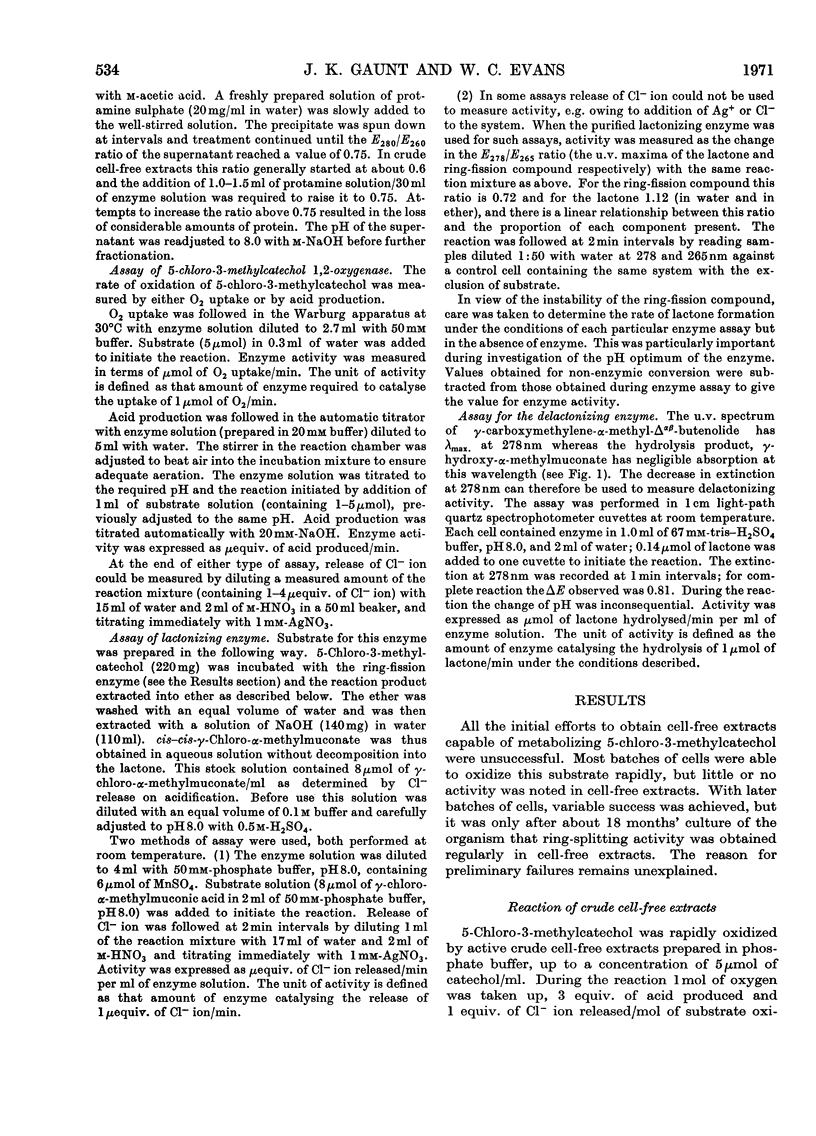Abstract
1. A cell-free system, prepared from Pseudomonas N.C.I.B. 9340 grown on 4-chloro-2-methylphenoxyacetate (MCPA) was shown to catalyse the reaction sequence: 5-chloro-3-methylcatechol → cis–cis-γ-chloro-α-methylmuconate → γ-carboxymethylene-α-methyl-Δαβ-butenolide → γ-hydroxy-α-methylmuconate. 2. The activity of the three enzymes involved in these reactions was completely resolved and the lactonizing and delactonizing enzymes were separated. 3. This part of the metabolic pathway of 4-chloro-2-methylphenoxyacetate is thus confirmed for this bacterium. 4. The ring-fission oxygenase required Fe2+ or Fe3+ and reduced glutathione for activity; the lactonizing enzyme is stimulated by Mn2+, Mg2+, Co2+ and Fe2+; no cofactor requirement could be demonstrated for the delactonizing enzyme. 5. cis–cis-γ-Chloro-α-methylmuconic acid was isolated and found to be somewhat unstable, readily lactonizing to γ-carboxymethylene-α-methyl-Δαβ-butenolide. 6. Enzymically the lactonization appears to be a single-step dehydrochlorinase reaction.
Full text
PDF









Selected References
These references are in PubMed. This may not be the complete list of references from this article.
- CAIN R. B., CARTWRIGHT N. J. On the properties of some aromatic ring-opening enzymes of species of the genus Nocardia. Biochim Biophys Acta. 1960 Jan 15;37:197–213. doi: 10.1016/0006-3002(60)90225-0. [DOI] [PubMed] [Google Scholar]
- CAIN R. B. The metabolism of protocatechuic acid by a vibrio. Biochem J. 1961 May;79:298–312. doi: 10.1042/bj0790298. [DOI] [PMC free article] [PubMed] [Google Scholar]
- DAGLEY S., EVANS W. C., RIBBONS D. W. New pathways in the oxidative metabolism of aromatic compounds by microorganisms. Nature. 1960 Nov 12;188:560–566. doi: 10.1038/188560a0. [DOI] [PubMed] [Google Scholar]
- EVANS W. C., SMITH B. S. W., LINSTEAD R. P., ELVIDGE J. A. Chemistry of the oxidative metabolism of certain aromatic compounds by micro-organisms. Nature. 1951 Nov 3;168(4279):772–775. doi: 10.1038/168772a0. [DOI] [PubMed] [Google Scholar]
- Evans W. C., Smith B. S., Moss P., Fernley H. N. Bacterial metabolism of 4-chlorophenoxyacetate. Biochem J. 1971 May;122(4):509–517. doi: 10.1042/bj1220509. [DOI] [PMC free article] [PubMed] [Google Scholar]
- Gaunt J. K., Evans W. C. Metabolism of 4-chloro-2-methylphenoxyacetate by a soil pseudomonad. Preliminary evidence for the metabolic pathway. Biochem J. 1971 May;122(4):519–526. doi: 10.1042/bj1220519. [DOI] [PMC free article] [PubMed] [Google Scholar]
- LIPKE H., KEARNS C. W. DDT dehydrochlorinase. II. Substrate and cofactor specificity. J Biol Chem. 1959 Aug;234(8):2129–2132. [PubMed] [Google Scholar]
- OTTEY L., TATUM E. L. Protocatechuic acid oxidase of Neurospora. J Biol Chem. 1956 Nov;223(1):307–311. [PubMed] [Google Scholar]
- Ribbons D. W., Evans W. C. Oxidative metabolism of phthalic acid by soil pseudomonads. Biochem J. 1960 Aug;76(2):310–318. doi: 10.1042/bj0760310. [DOI] [PMC free article] [PubMed] [Google Scholar]
- SISTROM W. R., STANIER R. Y. The mechanism of formation of beta-ketoadipic acid by bacteria. J Biol Chem. 1954 Oct;210(2):821–836. [PubMed] [Google Scholar]
- STANIER R. Y., INGRAHAM J. L. Protocatechuic acid oxidase. J Biol Chem. 1954 Oct;210(2):799–808. [PubMed] [Google Scholar]


